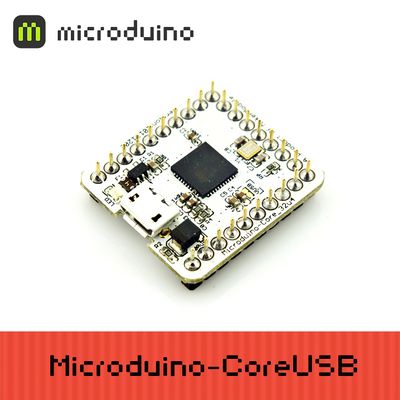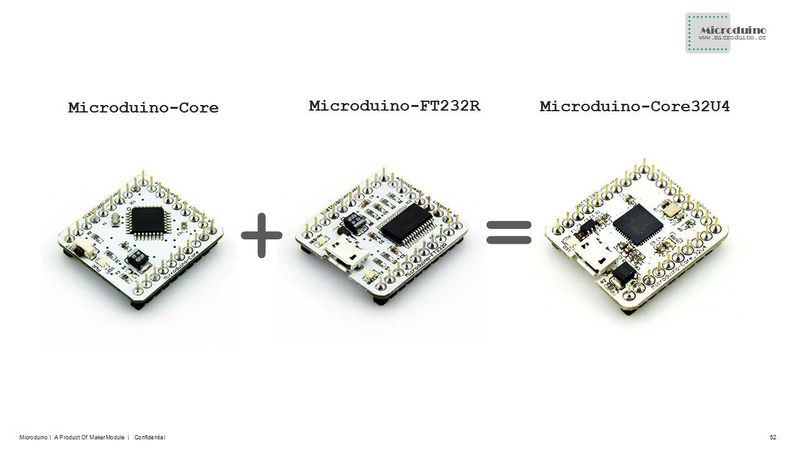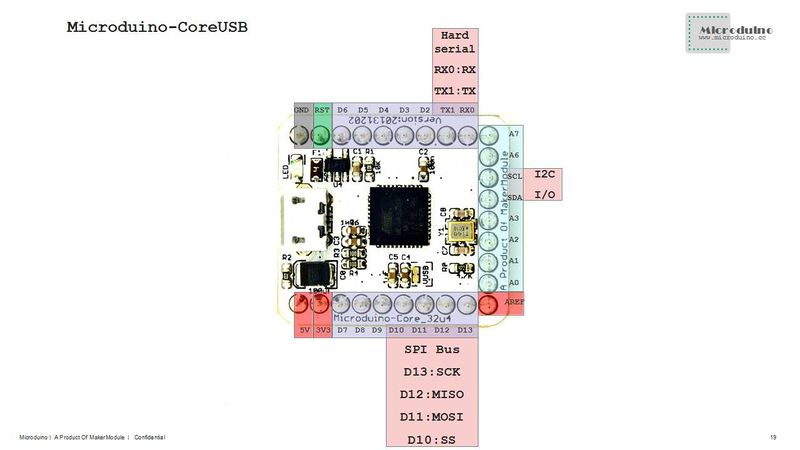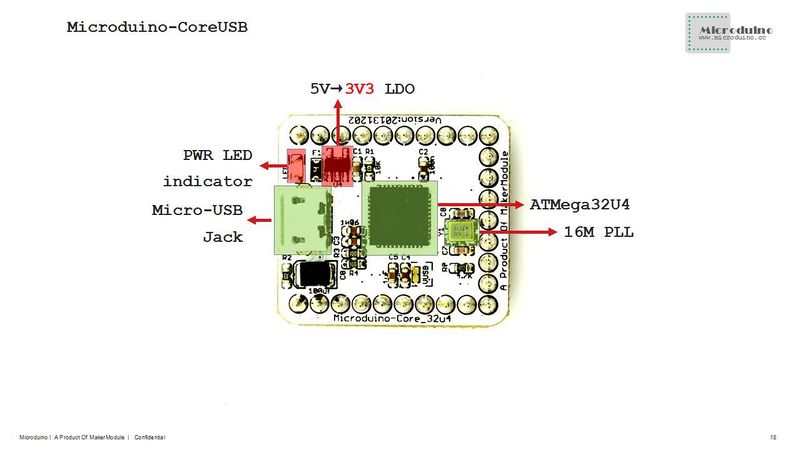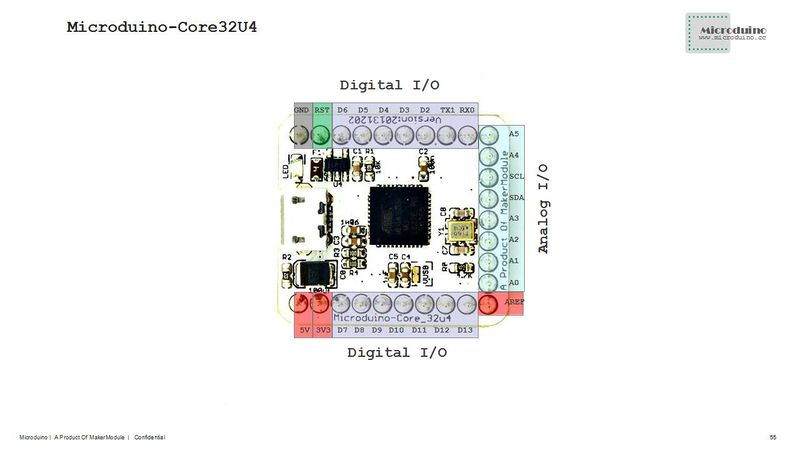Difference between revisions of "Microduino-Module CoreUSB"
(→Specifications) |
|||
| Line 21: | Line 21: | ||
*2.54mm (0.1 inch) pin pitch, compatible to bread board and pegboards. | *2.54mm (0.1 inch) pin pitch, compatible to bread board and pegboards. | ||
| − | == | + | ==Specification== |
| − | |||
| − | |||
| − | |||
| − | |||
| − | |||
| − | |||
| − | |||
| − | |||
| − | |||
| − | |||
| − | |||
| − | |||
| − | |||
| − | |||
| − | |||
| − | |||
| − | |||
{|class="wikitable" | {|class="wikitable" | ||
|- | |- | ||
| − | |Flash||32 | + | |Flash||32 KB(ATMEGA32U4). 4KB for bootstrap program. |
|- | |- | ||
|SRAM||2.5 KB(ATMEGA32U4) | |SRAM||2.5 KB(ATMEGA32U4) | ||
| Line 47: | Line 30: | ||
|EEPROM||1 KB(ATMEGA32U4) | |EEPROM||1 KB(ATMEGA32U4) | ||
|- | |- | ||
| − | | | + | |Frequency||16 MHz |
|} | |} | ||
| + | |||
| + | |||
| + | * 22 digital I/O ports: | ||
| + | ** In the module, it is marked with D0~D13 and A0~A7. | ||
| + | *10 analog I/O ports: | ||
| + | ** In the module, it is marked with A0, A1, A2, A3, A6, A7, D8(A8), D9(A9), D3(A10) and D4(A11). | ||
| + | **Each analog input port offers 10-bit resolution(namely, 0-1024). The analog voltage range is from GND to VCC by default. | ||
| + | **For more information, please refer to: '''[http://www.arduino.cc/en/Reference/AnalogRead analogRead()]''' function. | ||
| + | * PWM support: | ||
| + | ** In the module, it is marked with SCL, D3, D4, D5, D6, D7, D8 and D9 respectively. | ||
| + | ** For more information, please refer to:'''[http://www.arduino.cc/en/Reference/AnalogWrite analogWrite()]'''. | ||
| + | * Serial port support: | ||
| + | ** Virtual USB Serial; | ||
| + | ** In the module, it is marked with Serial1[D0(RX) and D1(TX)]. | ||
| + | * Support SPI: | ||
| + | ** In the module, it is marked with D13(SCK), D12(MISO), D11(MOSI) and D10(SS). | ||
| + | * Support I2C: | ||
| + | ** In the module, it is marked with SDA(D18) and SCL(D19). | ||
| + | * External interruption support: | ||
| + | ** In the module, it is marked with SCL(interrupt0), SDA(interrupt1), D0(interrupt2), D1(interrupt3) and D2(interrupt4). | ||
| + | ** For more information, please refer to:'''[http://arduino.cc/en/Reference/AttachInterrupt attachInterrupt()]'''. | ||
| + | * Support ISP download function. | ||
| + | * Support AREF. | ||
| + | |||
| + | *Pin Description: | ||
| + | |||
| + | {|class="wikitable" | ||
| + | | align="center" style="background:#f0f0f0;"|'''Pin''' | ||
| + | | align="center" style="background:#f0f0f0;"|'''Original Pin Name''' | ||
| + | | align="center" style="background:#f0f0f0;"|'''Map Pin Name''' | ||
| + | | align="center" style="background:#f0f0f0;"|'''Digital Pin''' | ||
| + | | align="center" style="background:#f0f0f0;"|'''Analog Pin''' | ||
| + | | align="center" style="background:#f0f0f0;"|'''interrupt''' | ||
| + | | align="center" style="background:#f0f0f0;"|'''PWM''' | ||
| + | | align="center" style="background:#f0f0f0;"|'''Serial''' | ||
| + | | align="center" style="background:#f0f0f0;"|'''SPI''' | ||
| + | | align="center" style="background:#f0f0f0;"|'''I2C''' | ||
| + | | align="center" style="background:#f0f0f0;"|'''Power''' | ||
| + | |- | ||
| + | | 1||VCC||+5V||||||||||||||||+5V | ||
| + | |- | ||
| + | | 2||VCC||+3V3||||||||||||||||+3.3V | ||
| + | |- | ||
| + | | 3||(OC0A/OC1C/#RTS)PB7||D7||D7||||||yes|||||||| | ||
| + | |- | ||
| + | | 4||(OC1B/0C4B/ADC13)PB6||D8||D8||A8||||yes|||||||| | ||
| + | |- | ||
| + | | 5||(OC1A/#OC4B/ADC12)PB5||D9||D9||A9||||yes|||||||| | ||
| + | |- | ||
| + | | 6||(SS)PB0||D10||D10||||||||||SS|||| | ||
| + | |- | ||
| + | | 7||(PDI/MOSI)PB2||D11||D11||||||||||MOSI|||| | ||
| + | |- | ||
| + | | 8||(PDO/MISO)PB3||D12||D12||||||||||MISO|||| | ||
| + | |- | ||
| + | | 9||(SCK)PB1||D13||D13||||||||||SCK|||| | ||
| + | |- | ||
| + | | 10||AREF||AREF|||||||||||||||| | ||
| + | |- | ||
| + | | 11||(ADC7/TDI)PF7||A0||D14||A0|||||||||||| | ||
| + | |- | ||
| + | | 12||(ADC6/TDO)PF6||A1||D15||A1|||||||||||| | ||
| + | |- | ||
| + | | 13||(ADC5/TMS)PF5||A2||D16||A2|||||||||||| | ||
| + | |- | ||
| + | | 14||(ADC4/TCK)PF4||A3||D17||A3|||||||||||| | ||
| + | |- | ||
| + | | 15||(SDA/INT1)PD1||SDA||D18||||1||||||||SDA|| | ||
| + | |- | ||
| + | | 16||(OC0B/SCL/INT0)PD0||SCL||D19||||0||yes||||||SCL|| | ||
| + | |- | ||
| + | | 17||(ADC1)PF1||A6||D20||A6|||||||||||| | ||
| + | |- | ||
| + | | 18||(ADC0)PF0||A7||D21||A7|||||||||||| | ||
| + | |- | ||
| + | | 19||(RXD1/AIN1/INT2)PD2||D0||D0||||2||||1(RX)|||||| | ||
| + | |- | ||
| + | | 20||(TXD1/INT3)PD3||D1||D1||||3||||1(TX)|||||| | ||
| + | |- | ||
| + | | 21||(INT6/AIN0)PE6||D2||D2||||4|||||||||| | ||
| + | |- | ||
| + | | 22||(T1/#OC4D/ADC9)PD6||D3||D3||A10||||yes|||||||| | ||
| + | |- | ||
| + | | 23||(T0/OC4D/ADC10)PD7||D4||D4||A11||||yes|||||||| | ||
| + | |- | ||
| + | | 24||(OC3A/#OC4A)PC6||D5||D5||||||yes|||||||| | ||
| + | |- | ||
| + | | 25||(ICP3/CLK0/OC4A)PC7||D6||D6||||||yes|||||||| | ||
| + | |- | ||
| + | | 26||RESET||RST|||||||||||||||| | ||
| + | |- | ||
| + | | 27||GND||GND||||||||||||||||GND | ||
| + | |} | ||
| + | |||
[[file:Microduino-Core32U4-Pinout.jpg|800px|thumb|center|Microduino-Core32U4-Pinout]] | [[file:Microduino-Core32U4-Pinout.jpg|800px|thumb|center|Microduino-Core32U4-Pinout]] | ||
| − | [[file:Microduino-Core32U4- | + | [[file:Microduino-Core32U4-Pinout1Big1.jpg|800px|thumb|center|Microduino-Core32U4-Pinout]] |
| − | [[file:Microduino-Core32U4- | + | [[file:Microduino-Core32U4-Pinout2Big1.jpg|800px|thumb|center|Microduino-Core32U4-Pinout]] |
[[file:Microduino-Core32U4-Pinout3.jpg|800px|thumb|center|Microduino-Core32U4-Pinout]] | [[file:Microduino-Core32U4-Pinout3.jpg|800px|thumb|center|Microduino-Core32U4-Pinout]] | ||
Revision as of 07:22, 17 December 2015
| Language: | English • 中文 |
|---|
|
Microduino CoreUSB module uses the ATMEGA32U4 series 8-bit MCU as the core, which is an open source and Arduino Leonardo compatible controller module. The difference between Microduino-CoreUSB and Microduino-Core/Microduino-Core+ is that it contains the microcontroller and USB communication. Its pin conforms to Microduino specification. Microduino CoreUSB use the same Java/C development environment with Arduino. The player can use Arduino IDE and with other software Flash or Processing to do the development. Also can use Microduino and other electronic components, modules, sensors, make a lot of interesting product. Contents[hide]Features
Specification
DocumentEagle PCB File:Microduino-core32U4.zip
Development
Detailed introduction for Arduino IDE, please refer to the tutorial. The player can use Arduino IDE and with other software Flash or Processing to do the development. Also can use Microduino and other electronic components, modules, sensors, make a lot of interesting product.
Burn Microduino BootLoader If the player was a Microduin CoreUSB empty board, you need to use the Arduino UNO or another Microduino to burn bootloader for another piece of Microduino empty board. Player can refer to the tutorial "Do you know how to use the Arduino UNO to burn bootloader for Microduino Core? Various version's Microduino-Core uses different bootloader. Initial bootloader optiboot is designed for ATmegaX8 series, which occupies only 512 bytes flash. Application
FQA
BugHistoryPictureFrontBackVideo |
